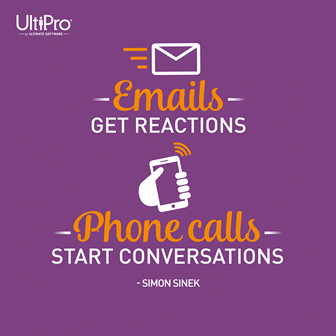Companies Must Identify Engagement Before They Can Impact It
(Editor’s Note: Today’s post is brought to you by our friends at Ultimate Software, a leading provider of human capital management solutions in the cloud. They were recently recognized as one of the 50 Most Engaged Workplaces in North America by Achievers. Congrats and enjoy the post!)
Employee engagement remains a top priority for business. Why? Because the results (or lack thereof) show that it needs to be. Two out of three employees are disengaged according to The Gallup Organization. This data has been stagnant for quite some time. We also know that engagement has an effect on the company culture, which in turn impacts the organization’s ability to hire and retain the best talent.
But the first step in solving any type of problem is to understand it. Not just the symptoms, but to understand the cause. When it comes to employee engagement, that means being able to define what engagement is and being in a position to identify engagement (or disengagement) behaviors within the organization.
Can managers identify engaged employees?
It starts with managers. They need to be in a position to clearly recognize the signs of engagement. If organizations look to managers to engage their teams, then managers should be able to spot the signs of employee engagement. Otherwise, how can they be held responsible for changing it?
Start with the definition. It might be tempting to think that everyone understands what employee engagement means, but I don’t know that’s the case. One person might equate engagement with employee satisfaction. Another with employees having a purpose. If your organization is looking to define employee engagement, this is one of the best employee engagement definitions I’ve come across.
Employee engagement lies at the intersection of maximum contribution for the business and maximum satisfaction for employees. It’s a sustainable level of high performance that benefits both the company and the employee.
While the definition is only a couple of sentences, it has many layers. There isn’t one characteristic or one metric to support the definition of employee engagement, which means there isn’t one action that managers can take to impact engagement. It’s more like a list of actions managers need to take to create engagement.
Now, wouldn’t it be great if that “list” was already prepared and ready for managers? Well, Ultimate Software’s Leadership Actions tool does exactly that. It identifies those everyday actions we need to take to positively impact employee engagement. With Leadership Actions, managers have access to different types of activities. Here are three examples:
1) Communication activities. These offer a starting point in your engagement strategy. How many times are we so busy with work and deadlines that we say to ourselves, “Let me just send them an email.” when we know the right thing to do is pick up the phone? Leadership Actions are quick reminders of the things we know we should be doing.
2) Work activities. Each individual leader can focus on activities that they feel align with their work responsibilities. For individuals to grow professionally, we have to play the role of coach – with our teams, colleagues, and ourselves. Leadership Actions reminds us of our responsibility to help others.
3) Culture activities. Encouraging activities that align with a great company culture are important. When we think long-term, managers have one job – to identify and train their replacement. Organizations don’t talk about it every day, but having managers focused on always finding and developing talent is critical to their success.
Leadership Actions is designed to help managers remember all the different activities that can contribute to engagement. Because let’s face it, sometimes we get distracted. And we don’t remember all of the tools we have available to us. Or we forget simply because we’re human.
For managers to truly have an impact in the organization, we have to give them the tools to truly understand engagement. It helps them hire the best talent. It improves productivity and performance. And, it improves retention. All things that determine our business success.
Speaking of business success, I’m excited to announce that I’ve partnered with Ultimate Software on a podcast series focused on how HR leaders can thrive in today’s business climate. We’ve launched a few shows and we’d love for you to check them out. The first is a discussion about company culture with Viv Maza, chief people officer for Ultimate Software, and Steve Browne, executive director of human resources at LaRosas Inc. It’s really a terrific conversation about building culture and not the same old, same old you’ve heard before. And I’m not just saying that because I’m a part of it. You can download the first show and check out the others on the Ultimate Software blog.
Managers are the key to the employee engagement strategy. But they need the tools and support to be successful. Organizations need to figure out how they will provide that support.
0